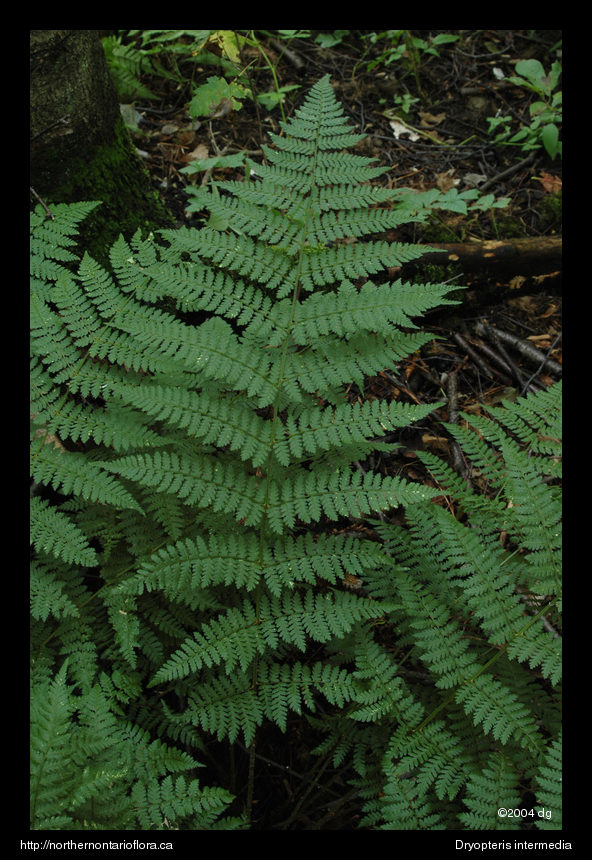
|
Northern Ontario Plant Database 
Plant DescriptionDryopteris intermedia (Muhl. ex Willd.) A.GrayEn: evergreen woodfern, intermediate woodfern, fancy fern, glandular woodfern
Dryopteridaceae (Wood fern Family) General: Perennial fern with similar sterile and fertile fronds (monomorphic); a crown of fronds arises from a thick, creeping rhizome. Fronds: Tripinnate, evergreen, to 1 m long. Fronds lanceolate to narrowly-triangular, pinnae opposite or nearly opposite. The scaly stalk of the frond (stipe) is shorter than the blade of the frond; the frond axis (rachis) bears glandular hairs. The lowest pair of pinnae have unequal pinnules (1), with the lower pinnules longer than the upper pinnules. Pinnules are lanceolate to ovate, divided into several oblong segments with narrow, pointed to bristle-tipped (spinulose) marginal teeth. In the lowermost pinnae, the second-closest pinnule to the rachis (2) is longer than the pinnule closest to the rachis. Sporangia: Arranged in clusters (sori) near the ends of the branched veins. Each sorus is covered by a kidney-shaped (reniform) indusium, 0.5–0.8 mm wide. Habitat and Range: Wet to dry woods and thickets. The evergreen woodfern is native to temperate and southern boreal eastern North America; in northern Ontario, its range extends around Lake Superior and northeast to the Moose River, but it is absent farther inland. Similar Species: The evergreen woodfern, D. intermedia, is similar to the spinulose woodfern, Dryopteris carthusiana, and the northern woodfern, Dryopteris expansa. These can be differentiated by the length and position of the lowermost pinnules. As shown in the table below, in D. intermedia, the pinnule 2nd closest to the rachis on the lowermost pinnae is the longest, while in D. carthusiana and D. expansa, the pinnule closest to the rachis is always the longest. The latter two species can be distinguished from each other by the position of the first lower (and longest) pinnule: in D. carthusiana, the first lower pinnule is opposite or within 4 mm of the first upper pinnule, while in D. expansa, the first lower pinnule is closest to the second upper pinnule. Dryopteris carthusiana also has fronds that are less divided (bipinnate) than the fronds of the other two Dryopteris species (both tripinnate) and has a much wider range, occurring throughout the James Bay watershed in northern Ontario. Compare the webpage of Dryopteris intermedia with that of Dryopteris carthusiana, from the Connecticut Ferns website, published by the Connecticut Botanical Society.
Back to species list |
||||||||||||||||||||||||||||||||||||||||||










